Government Competition, Land Supply Structure and Semi-Urbanization in China
Abstract
:1. Introduction
2. Impact Mechanism Analysis
2.1. Influence Mechanism of Land Finance on Population Semi-Urbanization
2.2. Influence Mechanism of Land-Motivated Investment on Population Semi-Urbanization
3. Model Construction, Variable Selection, and Data Sources
3.1. Model Construction
3.2. Variable Selection
3.2.1. Dependent Variable
3.2.2. Independent Variable
3.2.3. Intermediary Variable
3.2.4. Control Variable
3.3. Data Sources and Descriptive Statistics
4. Empirical Test Results and Analysis
4.1. Testing the Hypothesis on the Impact of Land Finance on Population Semi-Urbanization
4.2. Testing the Hypothesis Regarding the Effect of Land-Motivated Investment on Population Semi-Urbanization
4.3. Robustness Test
5. Conclusions and Discussion
Author Contributions
Funding
Data Availability Statement
Acknowledgments
Conflicts of Interest
Appendix A

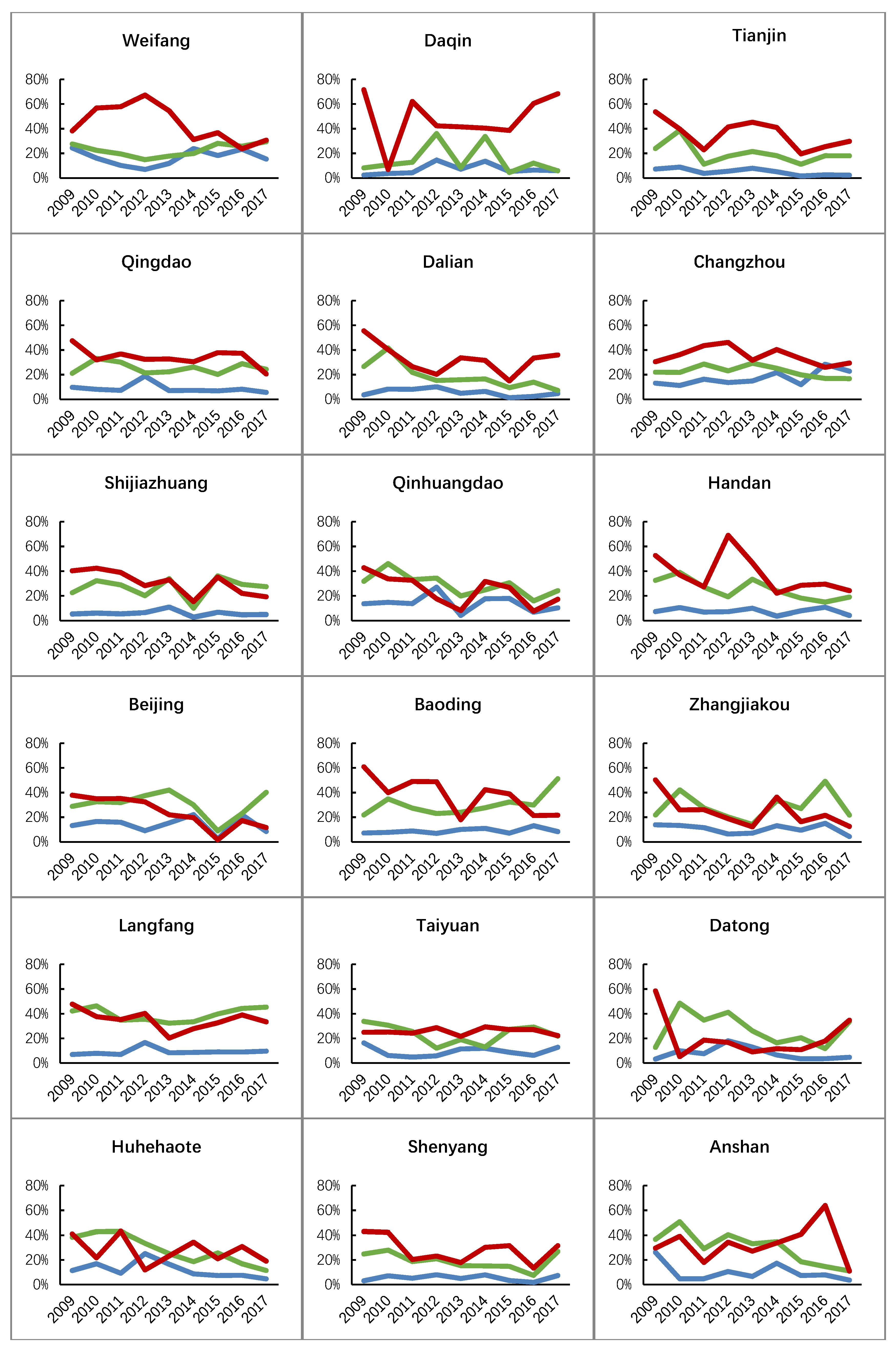
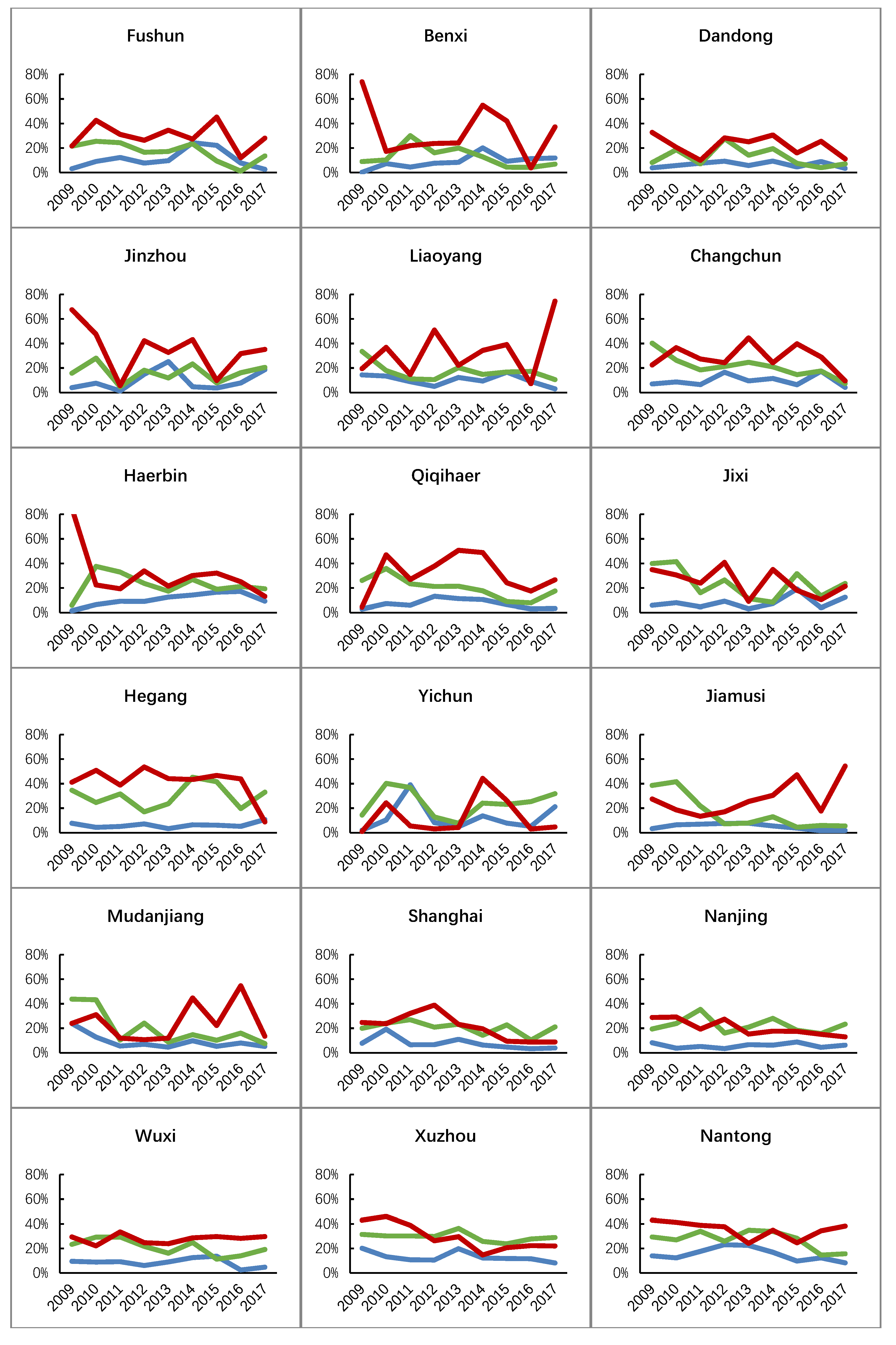


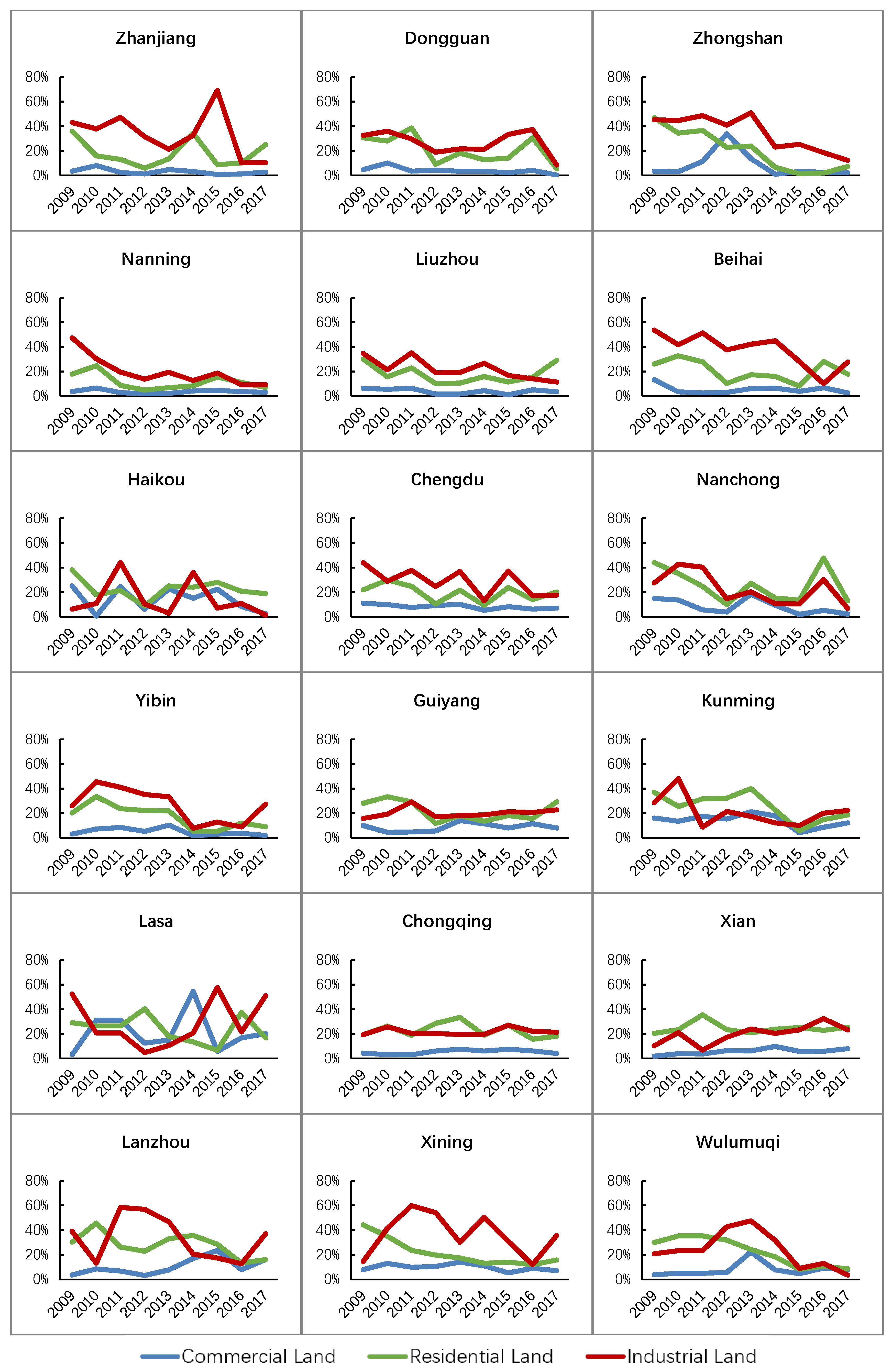
References
- Tisdale, H. The process of urbanization. Soc. Forces 1942, 3, 311–316. [Google Scholar] [CrossRef]
- Dociu, M.; Dunarintu, A. The socio-economic impact of urbanization. Int. J. Acad. Res. Account. Financ. 2012, 2, 47–52. [Google Scholar]
- Dekker, J.; Peen, J.; Koelen, J.; Smit, F.; Schoevers, R. Psychiatric disorders and urbanization in Germany. BMC Public Health 2008, 8, 17–26. [Google Scholar] [CrossRef] [PubMed]
- Yang, D.; Ye, C.; Xu, J. Land-use change and health risks in the process of urbanization: A spatiotemporal interpretation of a typical case in Changzhou, China. Land 2021, 10, 820. [Google Scholar] [CrossRef]
- Lin, X.; Wang, Y.; Wang, S.; Wang, D. Spatial differences and driving forces of land urbanization in China. J. Geogr. Sci. 2015, 25, 545–558. [Google Scholar] [CrossRef]
- Zhang, Y.; Xie, H. Interactive relationship among urban expansion, economic development, and population growth since the reform and opening up in China: An analysis based on a Vector Error Correction Model. Land 2019, 8, 153. [Google Scholar] [CrossRef] [Green Version]
- Huang, B.X.; Chiou, S.C.; Li, W.Y. Landscape pattern and ecological network structure in urban green space planning: A case study of Fuzhou city. Land 2021, 10, 769. [Google Scholar] [CrossRef]
- Zheng, Y.; Zhao, S.; Huang, J.; Lv, A. Analysis of the spatiotemporal pattern and mechanism of land use mixture: Evidence from China’s county data. Land 2021, 10, 370. [Google Scholar] [CrossRef]
- Chan, K.W.; Zhang, L. The Hukou System and Rural-Urban Migration in China: Processes and Changes. China Q. 1999, 160, 818–855. [Google Scholar] [CrossRef] [PubMed] [Green Version]
- Zhu, H.; Qian, J.X. New theoretical dialogues on migration in China: Introduction to the special issue. J. Ethn. Migr. Stud. 2021, 47, 2685–2705. [Google Scholar] [CrossRef] [Green Version]
- Chan, K.W. The Chinese Hukou System at 50. Eurasian Geogr. Econ. 2009, 50, 197–221. [Google Scholar] [CrossRef] [Green Version]
- Ji, Y.; Guo, X.; Zhong, S.; Wu, L. Land financialization, uncoordinated development of population urbanization and land urbanization, and economic growth: Evidence from China. Land 2020, 9, 481. [Google Scholar] [CrossRef]
- Wang, D.; Ren, C.; Zhou, T. Understanding the impact of land finance on industrial structure change in China: Insights from a spatial econometric analysis. Land Use Policy 2021, 103, 105323. [Google Scholar] [CrossRef]
- Lin, G.C.S.; Yi, F. Urbanization of capital or capitalization on urban land? Land Development and local public finance in urbanizing China. Urban Geogr. 2011, 32, 50–79. [Google Scholar] [CrossRef]
- Lin, G.C.S. China’s landed urbanization: Neo-liberalizing politics, land commodification, and municipal finance in the growth of metropolises. Environ. Plan. A Econ. Space 2014, 46, 1814–1835. [Google Scholar] [CrossRef]
- Tian, L.; Ge, B.; Li, Y. Impacts of state-led and bottom-up urbanization on land use change in the peri-urban areas of Shanghai: Planned growth or uncontrolled sprawl? Cities 2017, 60, 476–486. [Google Scholar] [CrossRef]
- Wang, B.; Zhang, Y.; Zhan, C.; Yang, X. Strategic interaction of industrial land conveyance behaviors in China: Based on an asymmetric two-regime Spatial Durbin Model. J. Clean. Prod. 2020, 270, 122598. [Google Scholar] [CrossRef]
- Cao, Y.; Liu, R.; Qi, W.; Wen, J. Urban land regulation and heterogeneity of housing conditions of inter-provincial migrants in China. Land 2020, 9, 428. [Google Scholar] [CrossRef]
- Zhou, L.; Fan, J.; Yu, X. The bilateral effect of intergovernmental competition on the level of urban land marketization: Based on the different functions of fiscal competition and investment attraction competition. China Land Sci. 2019, 33, 60–68. [Google Scholar] [CrossRef]
- Yan, J. Land supply regulation and residential land misallocation: An empirical study based on the city-level panel data. China Land Sci. 2018, 32, 15–22. [Google Scholar] [CrossRef]
- Dong, O.; Zhu, X.; Liu, X.; He, R.; Wan, Q. Spatial differentiation and driving factor analysis of urban construction land change in county-level city of Guangxi, China. Land 2021, 10, 691. [Google Scholar] [CrossRef]
- Wu, J.; Guo, Q.; Hewings, G.J.D. Land regulating economy as a policy instrument in urban China. Cities 2019, 94, 225–234. [Google Scholar] [CrossRef]
- Tian, L.; Ma, W. Government intervention in city development of China: A tool of land supply. Land Use Policy 2009, 26, 599–609. [Google Scholar] [CrossRef]
- Huang, J.; Shen, G.Q.; Zheng, H.W. Is insufficient land supply the root cause of housing shortage? Empirical evidence from Hong Kong. Habitat Int. 2015, 49, 538–546. [Google Scholar] [CrossRef]
- Li, H.; Zhou, L. Political Turnover and Economic Performance: The Incentive Role of Personnel Control in China. J. Public Econ. 2005, 89, 1743–1762. [Google Scholar] [CrossRef]
- Zhou, L.A. Governing China’s Local Officials: An Analysis of Promotion Tournament Model. Econ. Res. J. 2007, 7, 36–50. (In Chinese) [Google Scholar]
- Deng, J.; Zhang, N.; Ahmad, F.; Draz, M.U. Local government competition, environmental regulation intensity and regional innovation performance: An empirical investigation of Chinese provinces. Int. J. Environ. Res. Public Health 2019, 16, 2130. [Google Scholar] [CrossRef] [Green Version]
- Chen, Z.; Tang, J.; Wan, J.; Chen, Y. Promotion incentives for local officials and the expansion of urban construction land in China: Using the Yangtze River Delta as a case study. Land Use Policy 2017, 63, 214–225. [Google Scholar] [CrossRef]
- Wu, K.A.; Zhang, L. Developmentalist Government and Urban Hukou Threshold: Rethinking hukou system reform. Sociol. Stud. 2010, 25, 58–85. (In Chinese) [Google Scholar] [CrossRef]
- Wen, H.; Zhao, Z. Talent introduction and housing price: A tale of Xi’an. Appl. Econ. Lett. 2019, 26, 954–962. [Google Scholar] [CrossRef]
- Chen, J.; Hu, Z.M. Hukou-based labour market discrimination and ownership structure in urban China. Urban Stud. 2016, 53, 1657–1673. [Google Scholar] [CrossRef]
- Qian, Y.; Qian, Z. Assortative Mating by Education and Hukou in Shanghai. Chin. Sociol. Rev. 2017, 49, 239–262. [Google Scholar] [CrossRef] [Green Version]
- Zhang, Z.; Treiman, D.J. Social origins, hukou conversion, and the wellbeing of urban residents in contemporary China. Soc. Sci. Res. 2013, 42, 71–89. [Google Scholar] [CrossRef]
- Luo, J.; Chen, Y.F.; He, H.R.; Gao, G.L. Hukou identity and fairness in the ultimatum game. Theory Decis. 2019, 87, 389–420. [Google Scholar] [CrossRef]
- Hou, S.; Song, L.; Wang, J.; Ali, S. How land finance affects green economic growth in Chinese cities. Land 2021, 10, 819. [Google Scholar] [CrossRef]
- Qun, W.; Yongle, L.; Siqi, Y. The incentives of China’s urban land finance. Land Use Policy 2015, 42, 432–442. [Google Scholar] [CrossRef]
- Yan, S.; Ge, X.J.; Wu, Q. Government intervention in land market and its impacts on land supply and new housing supply: Evidence from major Chinese markets. Habitat Int. 2014, 44, 517–527. [Google Scholar] [CrossRef]
- Zhao, W.Z.; Yang, J.D. Financial gap of local governments and land transfer methods—An explanation based on the mutually beneficial behavior of local governments and state-owned enterprises. Manag. World 2015, 4, 11–24. (In Chinese) [Google Scholar] [CrossRef]
- Zheng, W.; Chen, P. The political economy of air pollution: Local development, sustainability, and political incentives in China. Energy Res. Soc. Sci. 2020, 69, 101707. [Google Scholar] [CrossRef]
- Yao, Y.; Zhang, M. Subnational leaders and economic growth: Evidence from Chinese cities. J. Econ. Growth 2015, 20, 405–436. [Google Scholar] [CrossRef]
- Yu, J.; Zhou, L.A.; Zhu, G. Strategic interaction in political competition: Evidence from spatial effects across Chinese cities. Reg. Sci. Urban Econ. 2016, 57, 23–37. [Google Scholar] [CrossRef] [Green Version]
- Shao, C.D.; Su, D.N.; Deng, H.T. Housing prices, land finance and city agglomeration characteristics: The road of China’s city development. Manag. World 2016, 2, 19–31. (In Chinese) [Google Scholar] [CrossRef]
- Tang, P.; Shi, X.; Qu, F. Local government competition and land financial strategies. Resour. Sci. 2014, 36, 702–711. [Google Scholar]
- Shang, H.; Li, W.; Liu, W. Innovation or imitation—A comparison of Performance Evaluation Models in China. Transylv. Rev. Adm. Sci. 2018, 54E, 138–154. [Google Scholar] [CrossRef]
- Huang, H.; Tang, Y. Residential land use regulation and the US housing price cycle between 2000 and 2009. J. Urban Econ. 2011, 71, 93–99. [Google Scholar] [CrossRef]
- Wen, L.; Peng, D.Y. Research on misallocation of land supply, rising housing prices and semi-urbanization. China Land Sci. 2016, 30, 18–27. (In Chinese) [Google Scholar] [CrossRef]
- Fan, J.; Zhou, L.; Yu, X.; Zhang, Y. Impact of land quota and land supply structure on China’s housing prices: Quasi-natural experiment based on land quota policy adjustment. Land Use Policy 2021, 106, 105452. [Google Scholar] [CrossRef]
- Xiong, C.; Tan, R. Will the land supply structure affect the urban expansion form? Habitat Int. 2018, 75, 25–37. [Google Scholar] [CrossRef]
- Zhang, L.; Gao, Y.H.; Xu, X.X. Land transfer under the collusion of governments and enterprises. Manag. World 2013, 12, 43–51. (In Chinese) [Google Scholar] [CrossRef]
- Tu, F.; Yu, X.; Ruan, J. Industrial land use efficiency under government intervention: Evidence from Hangzhou, China. Habitat Int. 2014, 43, 1–10. [Google Scholar] [CrossRef]
- Yang, Q.J.; Zhuo, P.; Yang, J.D. Industrial land transfer and bottom line competition of investment quality—An empirical study based on the panel data of China’s prefecture level cities from 2007 to 2011. Manag. World 2014, 11, 24–34. (In Chinese) [Google Scholar] [CrossRef]
- Yuan, F.; Wei, Y.D.; Xiao, W. Land marketization, fiscal decentralization, and the dynamics of urban land prices in transitional China. Land Use Policy 2019, 89, 104208. [Google Scholar] [CrossRef]
- Fitzgerald, M.; Hansen, D.J.; McIntosh, W.; Slade, B.A. Urban land: Price indices, performance, and leading indicators. J. Real Estate Financ. Econ. 2020, 60, 396–419. [Google Scholar] [CrossRef]
- Huang, Z.; Du, X. Government intervention and land misallocation: Evidence from China. Cities 2017, 60, 323–332. [Google Scholar] [CrossRef]
- Wu, Y.; Zhang, X.; Skitmore, M.; Song, Y.; Hui, E.C.M. Industrial land price and its impact on urban growth: A Chinese case study. Land Use Policy 2014, 36, 199–209. [Google Scholar] [CrossRef] [Green Version]
- Chen, B.K.; Yang, R.D. Land supply, housing price and household saving in urban China: Evidence from urban household survey. Econ. Res. J. 2013, 48, 110–122. (In Chinese) [Google Scholar]
- Xie, D.S. Land supply intervention and urban-rural income gap—Based on panel data of 105 cities in China. Econ. Sci. 2018, 3, 35–48. (In Chinese) [Google Scholar] [CrossRef]
- Baron, R.M.; Kenny, D.A. Baron & Kenny, 1986. J. Personal. Soc. Psychol. 1986, 51, 1173–1182. [Google Scholar]
- Nam, J.; Ekinci, Y.; Whyatt, G. Brand equity, brand loyalty and consumer satisfaction. Ann. Tour. Res. 2011, 38, 1009–1030. [Google Scholar] [CrossRef]
- Tofighi, D.; Mackinnon, D.P. RMediation: An R Package for Mediation Analysis Confidence Intervals. Behav. Res. Methods 2011, 43, 692–700. [Google Scholar] [CrossRef] [Green Version]
- Liu, Q.Q.; Zhou, Z.K.; Yang, X.J.; Kong, F.C.; Niu, G.F.; Fan, C.Y. Mobile phone addiction and sleep quality among Chinese adolescents: A moderated mediation model. Comput. Hum. Behav. 2017, 72, 108–114. [Google Scholar] [CrossRef]
- Wang, Y.L.; Huang, Z.M.; Kong, F. Parenting stress and life satisfaction in mothers of children with cerebral palsy: The mediating effect of social support. J. Health Psychol. 2020, 25, 416–425. [Google Scholar] [CrossRef]
- MacKinnon, D.P.; Warsi, G.; Dwyer, J.H. A simulation study of mediated effect measures. Multivar. Behav. Res. 1995, 30, 41–62. [Google Scholar] [CrossRef] [Green Version]
- Wen, Z.L.; Hau, K.T.; Chang, L. A comparison of moderator and mediator and their applications. Acta Psychol. Sin. 2005, 37, 268–274. (In Chinese) [Google Scholar]
- Reed, W.R. On the Practice of Lagging Variables to Avoid Simultaneity. Oxf. Bull. Econ. Stat. 2015, 77, 897–905. [Google Scholar] [CrossRef]
- Bellemare, M.F.; Masaki, T.; Pepinsky, T.B. Lagged Explanatory Variables and the Estimation of Causal Effect. J. Polit. 2017, 79, 949–963. [Google Scholar] [CrossRef]
- Dormann, C.; Griffin, M.A. Optimal Time Lags in Panel Studies. Psychol. Methods 2015, 20, 489–505. [Google Scholar] [CrossRef]
- Liu, X.; Cao, G.; Liu, T.; Liu, H. Semi-urbanization and evolving patterns of urbanization in China: Insights from the 2000 to 2010 national censuses. J. Geogr. Sci. 2016, 26, 1626–1642. [Google Scholar] [CrossRef]
- Zhu, Y. Research on the land system arrangement and peri urbanization: Division, argument and extension. China Popul. Resour. Environ. 2018, 28, 29–36. [Google Scholar] [CrossRef]
- Hou, X.P. Local government behavior and dual population urbanization: An spatial econometric analysis based on Chinese provincial panel data. Econ. Probl. 2019, 11, 96–103. (In Chinese) [Google Scholar] [CrossRef]
- Fan, J.; Zhou, L.; Yu, X. Impact of land finance and land market development on urban housing price. Sci. Geogr. Sin. 2021, 41, 863–871. [Google Scholar] [CrossRef]
- Shi, F.; Xu, Y. Study on spatial-temporal differences and driving forces of the relationship between land finance and industrial development in China. Geogr. Geo-Inf. Sci. 2020, 36, 110–115. [Google Scholar] [CrossRef]
- Chen, T.; Kung, J.K.S. Do land revenue windfalls create a political resource curse? Evidence from China. J. Dev. Econ. 2016, 123, 86–106. [Google Scholar] [CrossRef]
- Wang, J.; Skidmore, M.; Wu, Q.; Wang, S. The impact of a tax cut reform on land finance revenue: Constrained by the binding target of construction land. J. Urban Aff. 2020, 1803750. [Google Scholar] [CrossRef]
- Sun, X.L.; Zhou, F.Z. Land Finance and the tax-sharing system: An empirical interpretation. Soc. Sci. China 2014, 35, 47–64. [Google Scholar] [CrossRef]
- Li, Y.G.; Wang, M. Land finance and industrial structure tertiarization: A new perspective of an explanation of “Chinese Paradox” of industrial structure tertiarization. J. Financ. Econ. 2015, 41, 29–41. (In Chinese) [Google Scholar] [CrossRef]
- Fu, Y.; Zhang, Y. The China-style of decentralization and fiscal expenditure composition: The cost of competition for growth. Manag. World 2007, 3, 4–22. [Google Scholar] [CrossRef]
- Ihlanfeldt, K.R. The effect of land use regulation on housing and land prices. J. Urban Econ. 2006, 61, 420–435. [Google Scholar] [CrossRef]
- Huang, J.B.; Xu, Z.; Xu, S. Land price distortion, enterprises’ property and over-investment—An empirical research based on the data of Chinese industrial enterprises and land price of cities in China. China Ind. Econ. 2015, 3, 57–69. (In Chinese) [Google Scholar] [CrossRef]
- Li, L.X.; Huang, P.Y.; Ma, G.R. Mismatch of land resources and productivity difference of Chinese industrial enterprises. Manag. World 2016, 8, 86–96. (In Chinese) [Google Scholar] [CrossRef]
- Yu, L.L.; Cai, Y.Y. Land supply structure, financial pressure and housing price: Empirical evidence from Guangdong province. China Land Sci. 2018, 32, 30–36. (In Chinese) [Google Scholar] [CrossRef]
- Zhang, S.H.; Yu, Y.Z. Land lease, resource misallocation and total factor productivity. J. Financ. Econ. 2019, 45, 73–85. (In Chinese) [Google Scholar] [CrossRef]
| 1 | The urban–rural dualism in the People’s Republic of China was codified in 1958 with the issue of the Regulations on Registration (Hukou Policy), one fundamental social and political–institutional arrangement in China. The hukou can be transferred in the process of rural–urban migration, but such a transfer exerts a significant influence on the pace of urbanization and regional development in contemporary China. |
| 2 | While the Hukou Policy is the immediate cause of the phenomenon of population semi-urbanization, it is not the root cause. |
| 3 | The definition of the rate of population semi-urbanization, as derived from geography textbooks in China, refers to the difference between the urbanization rate of the permanent population and that of the registered population. The permanent population refers to the people who have lived in the place of residence for more than half a year, and the registered population refers to the people who have registered permanent residence with the public security household registration authority in the place of residence. |
| 4 | We guess that the sudden drop in 2015 may be related to the Hukou Policy introduced in 2014. “Under the plan, China will completely remove restrictions concerning households in towns and small cities”. Such plan certainly led to a significant increase in the number of registered residents in the short term, so the rate of population semi-urbanization suddenly dropped in 2015. The sudden rise in 2020 may be related to the China Seventh Census. The data of the urbanization rate of the permanent population in 2020 is from the China Seventh Census; this census is a comprehensive survey and conducted every ten years, which greatly reduces the probability of under-reporting. This means that the urban permanent population that was originally misreported was counted in the China Seventh Census, so the rate of population semi-urbanization increased in 2020. |
| 5 | Tax-sharing reform was implemented in 1994 in China, dividing tax into three types: central tax, local tax, and shared tax. After the tax-sharing reform, 100% consumption tax and 75% of VAT belong to the central government. As a direct result of the tax-sharing reform, the proportion of local fiscal revenue in the national total fiscal revenue dropped rapidly from 78% in 1993 to 44.3% in 1994, which caused a huge impact on local fiscal pressure. At the same time, the ratio of local governments’ revenue to expenditure has been maintained at about 70%, and the tax-sharing reform has formed a financial gap of almost 30% of local governments. |
| 6 | Agreement assignment can specify matters related to enterprise investments other than the price and can well specify the interests between the enterprise and the government, while other transfer ways, such as bidding transfer or auction sale, cannot be well applied to this kind of transaction. However, agreement transfer’s operation process is often not under supervision; only a few developers have the opportunity to negotiate with the transferor, and this kind of transaction is usually in a “black box”. As a result, better developers without relevant information are excluded from the transaction. |
| 7 | The 105 key cities are representative cities selected by China central government based on different levels of economic development, and these cities cover the eastern, middle, and western regions, which can comprehensively reflect the urban development level in China. |
| 8 | We limited this research from 2007 to 2017, because the data during this period are relatively complete, and EPS China Data has not published most of the related data after 2017. |
| 9 | As mentioned in Section 3.1, the effect level of mediating effect is often measured by ab/c or ab/c’; here, it is ab/c, i.e., 0.217 × 0.157/0.25 = 13.63%. |
| 10 | As mentioned in Section 3.1, the effect level of mediating effect is often measured by ab/c or ab/c’; here, it is ab/c, i.e., 0.049 × 0.606/0.25 = 11.88%. |
| 11 | “Under the plan, China will completely remove restrictions concerning households in towns and small cities, gradually ease restrictions in mid-sized cities, and set reasonable conditions for people settling in big cities.”—China Introduces Guidelines for Household Registration Reform (Link: http://english.www.gov.cn/news/news_release/2014/08/23/content_281474983030658.htm, accessed on 20 November 2021). |
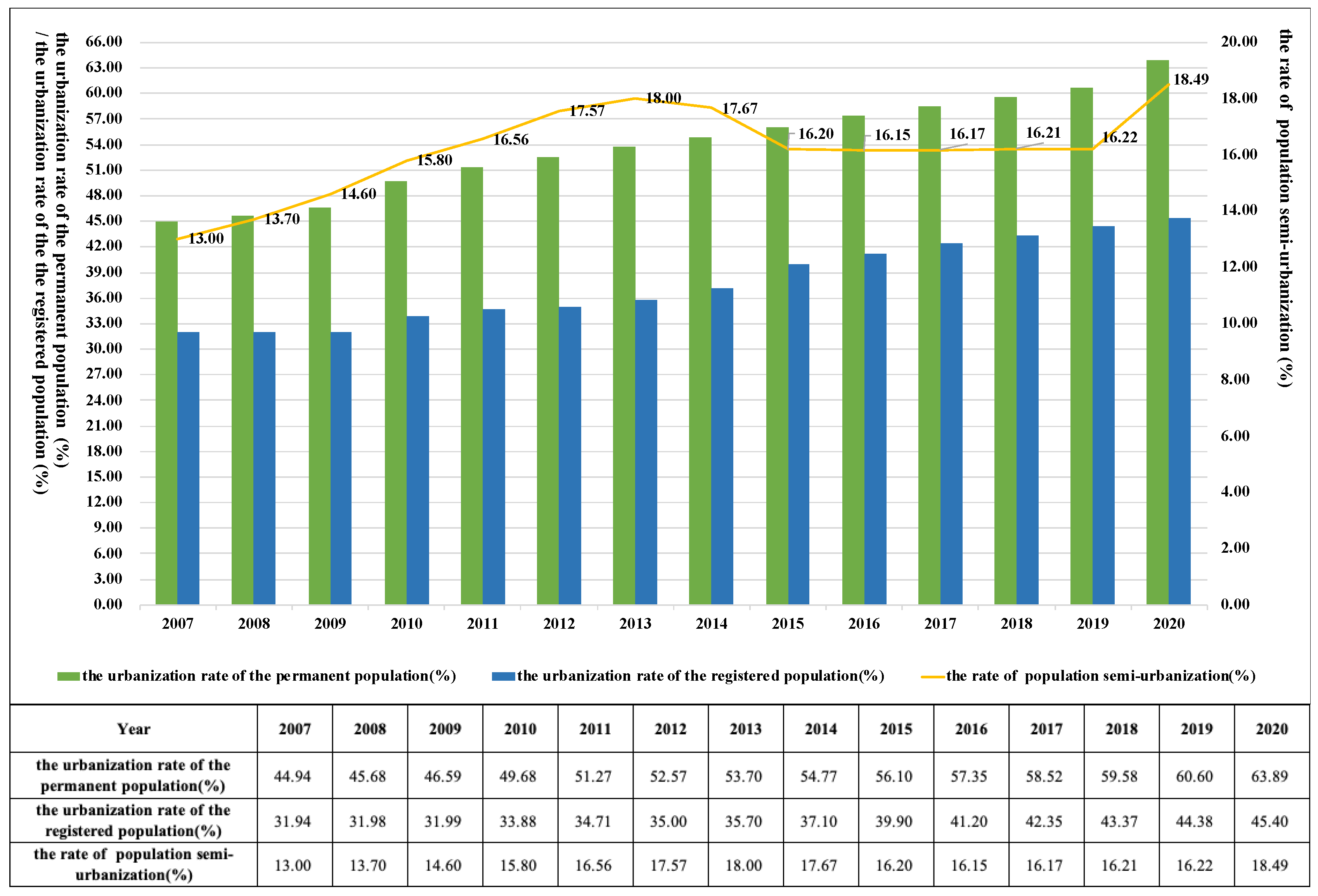

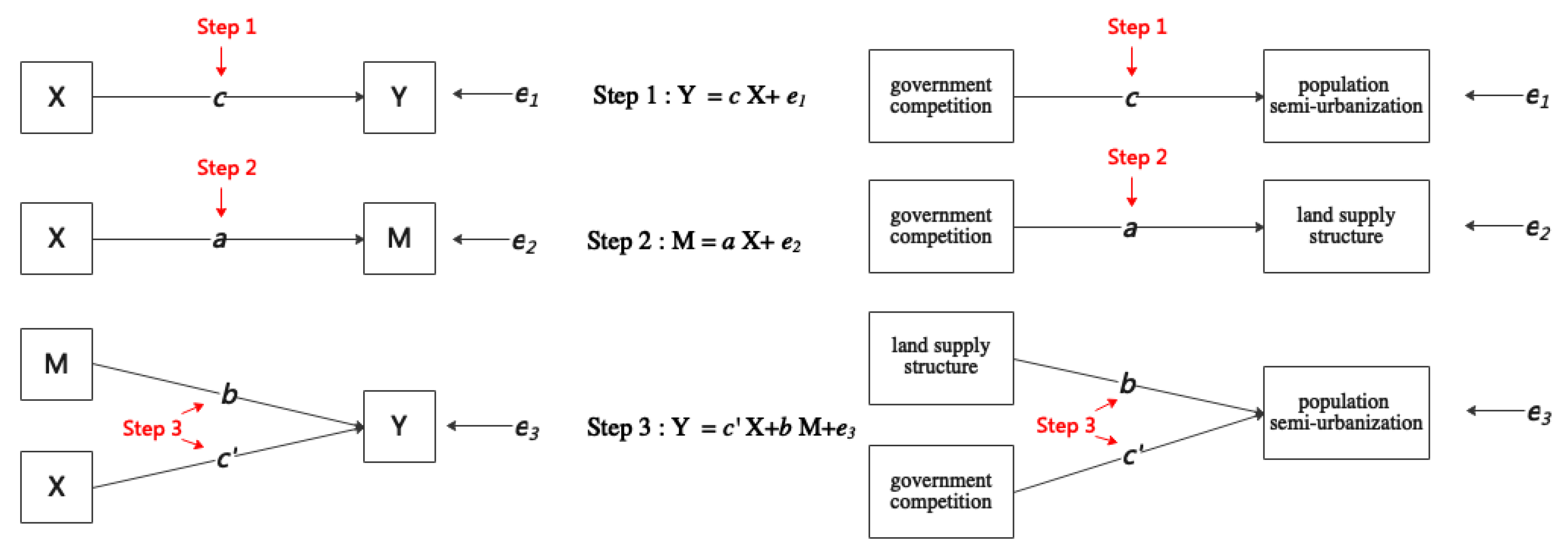
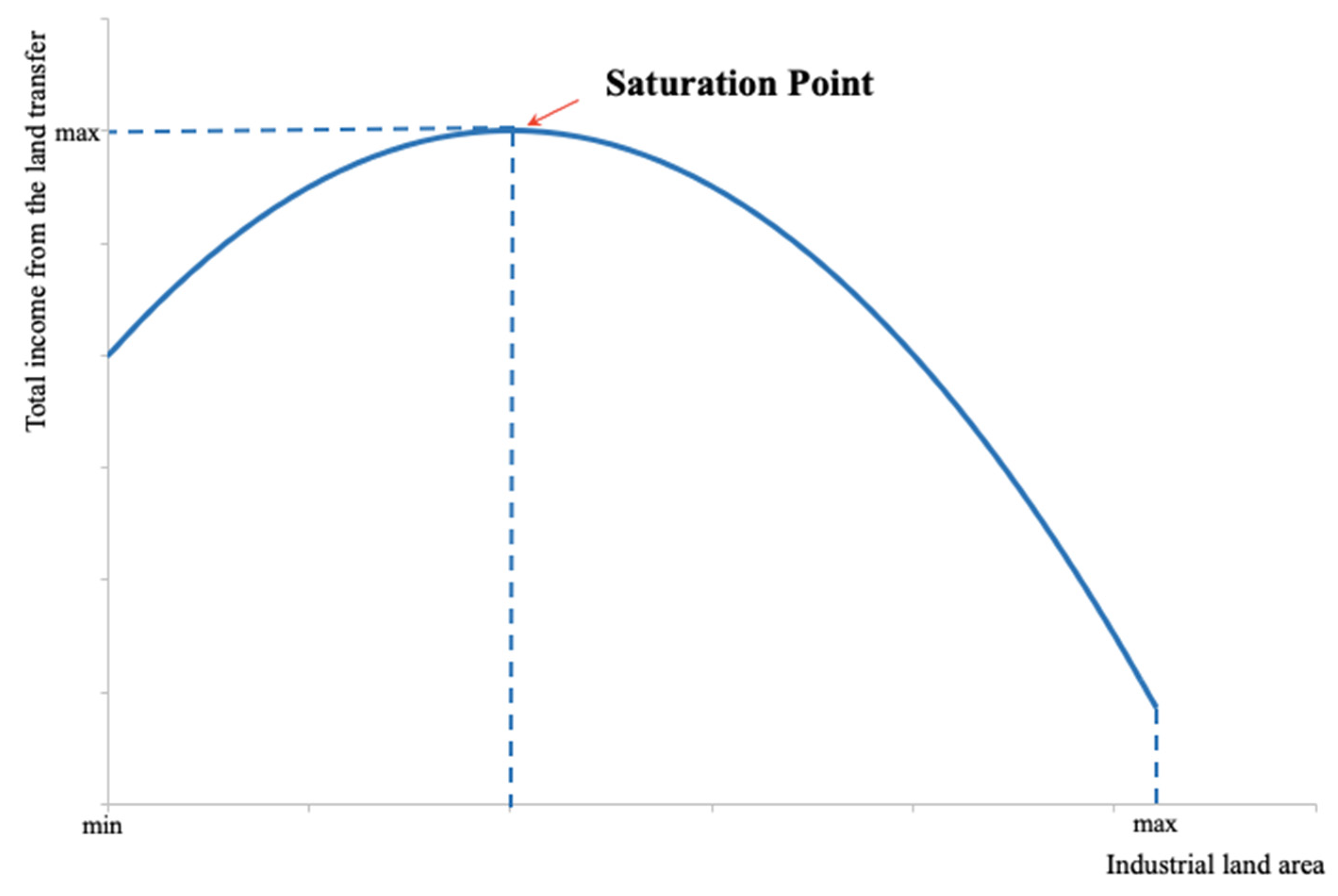
| Observation Number | Mean | Minimum | Maximum | Standard Deviation | |
|---|---|---|---|---|---|
| Commercial land | 944 | 8.55% | 0.24% | 54.59% | 5.54 |
| Residential land | 945 | 22.32% | 1.21% | 51.77% | 9.78 |
| Industrial land | 945 | 30.24% | 1.06% | 85.14% | 30.24 |
| Variable Type | Variable Name | Variable Code | Variable Definition | Unit | Observation Number | Mean | Standard Deviation | Minimum | Maximum |
|---|---|---|---|---|---|---|---|---|---|
| Dependent Variable | Rate of population semi-urbanization | semi | Difference between the urbanization rate of the permanent population and that of the registered population | % | 906 | 20.60 | 14.34 | 0 | 77.30 |
| Independent Variable | Government competition | fiscal | Land transfer fees | 10 thousand yuan | 985 | 1,797,499 | 3,207,666 | 58 | 28,000,000 |
| capital | Ratio of FDI to GDP | - | 1155 | 0.03 | 0.02 | 0 | 0.13 | ||
| Intermediary Variable | Land supply structure | price | Ratio of residential land price to industrial land price | - | 944 | 6.15 | 5.24 | 1.19 | 47.26 |
| area | Ratio of industrial land area to residential land area | - | 945 | 1.72 | 1.58 | 0.07 | 18.52 | ||
| Control Variable | City characteristics | pgdp | Per capita GDP | yuan/person | 1155 | 54,829.84 | 35,277.09 | 8001 | 467,749 |
| resource | Per capita construction land area | m2/person | 1155 | 101.64 | 57.89 | 9.95 | 540.18 | ||
| nonagro | Proportion of output value of secondary and tertiary industries | % | 1155 | 91.00 | 7.37 | 57.07 | 99.97 | ||
| estate | Real estate development investment | 10 thousand yuan | 1155 | 4,831,438 | 6,509,225 | 17,431 | 42,400,000 | ||
| book | Total book collections of public libraries | thousand | 1155 | 5123.72 | 9192.76 | 193 | 77,730 | ||
| Personal characteristics of officials | age | Age of officials | year old | 1155 | 51.83 | 3.93 | 41 | 64 | |
| education | Education level of officials: 0 = below undergraduate, 1 = undergraduate, 2 = master’s degree, 3 = doctorate or above | - | 1155 | 2.04 | 0.71 | 0 | 3 | ||
| localization | local promotion or not, 1 = yes, 0 = no | - | 1155 | 0.36 | 0.48 | 0 | 1 | ||
| tenure | Actual term of office; if officials’ term in post dates from January to June, it is calculated from the current year; if it began from July to December, it is calculated from the following year | year | 1155 | 2.62 | 1.69 | 0 | 12 | ||
| Surrogate Variable for Robustness Test | Rate of population semi-urbanization | semi’ | Ratio of the urbanization rate of the permanent population to that of the registered population | - | 906 | 1.56 | 0.50 | 1.00 | 4.21 |
| Group without Control Variables | Taking Land Price Structure as Intermediary Variable | Taking Land Area Structure as Intermediary Variable | ||||
|---|---|---|---|---|---|---|
| (1.1) | (2.1) | (3.1) | (1.2) | (2.2) | (3.2) | |
| Semi | Mismatch (Price) | Semi | Semi | Mismatch (Area) | Semi | |
| fiscal | 1.021 *** | 0.954 *** | 0.353 | 1.021 *** | −0.471 *** | 0.372 |
| (0.128) | (0.126) | (0.256) | (0.128) | (0.082) | (0.255) | |
| mismatch(price) | 0.317 *** | |||||
| (0.07) | ||||||
| mismatch(area) | −0.536 *** | |||||
| (0.121) | ||||||
| _cons | 7.266 *** | −6.23 *** | 14.326 *** | 7.266 *** | 8.026 *** | 16.824 *** |
| (2.047) | (1.696) | (3.575) | (2.047) | (1.107) | (3.591) | |
| Observations | 823 | 744 | 574 | 823 | 742 | 574 |
| Group with Control Variables | Taking Land Price Structure as Intermediary Variable | Taking Land Area Structure as Intermediary Variable | ||||
| (1.1) | (2.1) | (3.1) | (1.2) | (2.2) | (3.2) | |
| Semi | Mismatch (Price) | Semi | Semi | Mismatch (Area) | Semi | |
| fiscal | 0.489 *** | 0.424 *** | 0.352 | 0.489 *** | −0.415 *** | 0.339 |
| (0.173) | (0.157) | (0.273) | (0.173) | (0.093) | (0.272) | |
| mismatch(price) | 0.294 *** | |||||
| (0.072) | ||||||
| mismatch(area) | −0.547 *** | |||||
| (0.12) | ||||||
| pgdp | 1.875 ** | 1.255 ** | 2.187 ** | 1.875 ** | 0.355 | 2.529 ** |
| (0.919) | (0.552) | (1.022) | (0.919) | (0.347) | (1.016) | |
| nonagro | 0.095 | 0.022 | 0.293 * | 0.095 | −0.01 | 0.319 * |
| (0.136) | (0.066) | (0.167) | (0.136) | (0.069) | (0.167) | |
| resource | 0.929 | −0.167 | 1.292 | 0.929 | 0.242 | 0.868 |
| (0.753) | (0.56) | (1.038) | (0.753) | (0.337) | (1.03) | |
| estate | −0.047 | 0.725 ** | −1.335 ** | −0.047 | −0.395 * | −1.349 ** |
| (0.557) | (0.347) | (0.677) | (0.557) | (0.216) | (0.674) | |
| book | 1.219 *** | 0.015 | 1.158 ** | 1.219 *** | 0.157 | 1.148 ** |
| (0.465) | (0.289) | (0.537) | (0.465) | (0.173) | (0.535) | |
| age | 0.086 | 0.036 | 0.04 | 0.086 | −0.011 | 0.051 |
| (0.055) | (0.036) | (0.062) | (0.055) | (0.019) | (0.062) | |
| education | 0.084 | 0.56 *** | 0.232 | 0.084 | 0.081 | 0.359 |
| (0.263) | (0.18) | (0.314) | (0.263) | (0.097) | (0.311) | |
| tenure | −0.12 | −0.076 | −0.056 | −0.12 | −0.009 | −0.052 |
| (0.098) | (0.063) | (0.102) | (0.098) | (0.033) | (0.101) | |
| local | 0.513 | −0.084 | 0.702 | 0.513 | −0.218 | 0.757 |
| (0.438) | (0.286) | (0.504) | (0.438) | (0.156) | (0.501) | |
| _cons | −32.333 *** | −27.845 *** | −33.892 ** | −32.333 *** | 8.382 | −35.823 ** |
| (11.209) | (5.618) | (13.971) | (11.209) | (5.622) | (13.921) | |
| Observations | 823 | 741 | 574 | 823 | 742 | 574 |
| Group without Control Variables | Taking Land Price Structure as Intermediary Variable | Taking Land Area Structure as Intermediary Variable | ||||
|---|---|---|---|---|---|---|
| (1.3) | (2.3) | (3.3) | (1.4) | (2.4) | (3.4) | |
| Semi | Mismatch (Price) | Semi | Semi | Mismatch (Area) | Semi | |
| capital | 0.404 *** | 0.355 *** | 0.326 ** | 0.404 *** | 0.038 | 0.331 ** |
| (0.144) | (0.082) | (0.138) | (0.144) | (0.03) | (0.137) | |
| mismatch(price) | 0.208 *** | |||||
| (0.071) | ||||||
| mismatch(area) | 0.726 *** | |||||
| (0.173) | ||||||
| _cons | 20.661 *** | 5.945 *** | 19.891 *** | 20.661 *** | 1.751 *** | 19.899 *** |
| (0.188) | (00.463) | (0.467) | (0.188) | (0.085) | (0.356) | |
| Observations | 918 | 835 | 743 | 918 | 875 | 744 |
| Group with Control Variables | Taking Land Price Structure as Intermediary Variable | Taking Land Area Structure as Intermediary Variable | ||||
| (1.3) | (2.3) | (3.3) | (1.4) | (2.4) | (3.4) | |
| Semi | Mismatch (Price) | Semi | Semi | Mismatch (Area) | Semi | |
| capital | 0.25* | 0.217 *** | 0.282 ** | 0.25 * | 0.049 * | 0.292 ** |
| (0.14) | (0.08) | (0.14) | (0.14) | (0.03) | (0.138) | |
| mismatch(price) | 0.157 ** | |||||
| (0.074) | ||||||
| mismatch(area) | 0.606 *** | |||||
| (0.184) | ||||||
| pgdp | 2.188 ** | 0.835 * | 2.24 ** | 2.188 ** | 0.85 *** | 1.982 * |
| (0.934) | (0.498) | (1.049) | (0.934) | (0.222) | (1.048) | |
| nonagro | 0.082 | 0.058 | 0.144 | 0.082 | 0.011 | 0.12 |
| (0.149) | (0.057) | (0.19) | (0.149) | (0.037) | (0.189) | |
| resource | 0.7 | −0.226 | 0.077 | 0.7 | 0.316 | −0.119 |
| (0.768) | (0.505) | (1.039) | (0.768) | (0.217) | (1.033) | |
| estate | 0.264 | 1.075 *** | −0.656 | 0.264 | −0.114 | −0.456 |
| (0.555) | (0.294) | (0.669) | (0.555) | (0.135) | (0.662) | |
| book | 0.769 | 0.105 | −0.133 | 0.769 | 0.131 | −0.32 |
| (0.5) | (0.263) | (0.545) | (0.5) | (0.117) | (0.543) | |
| age | 0.135 ** | 0.027 | 0.116 * | 0.135 ** | 0.011 | 0.111 * |
| (0.057) | (0.032) | (0.06) | (0.057) | (0.013) | (0.06) | |
| education | 0.294 | 0.341 ** | 0.432 | 0.294 | 0.047 | 0.41 |
| (0.266) | (0.159) | (0.301) | (0.266) | (0.063) | (0.299) | |
| tenure | −0.143 | −0.053 | −0.101 | −0.143 | −0.062 *** | −0.065 |
| (0.1) | (0.057) | (0.104) | (0.1) | (0.023) | (0.104) | |
| local | 0.83 ** | −0.053 | 0.911 ** | 0.83 ** | −0.023 | 0.94 ** |
| (0.42) | (0.242) | (0.456) | (0.42) | (0.097) | (0.452) | |
| _cons | −30.792 ** | −26.076 *** | −13.65 | −30.792 ** | −9.853 *** | −9.187 |
| (12.205) | (5.123) | (16.14) | (12.205) | (3.058) | (16.13) | |
| Observations | 916 | 833 | 741 | 916 | 873 | 742 |
| Group | Taking Land Price Structure as Intermediary Variable | Taking Land Area Structure as Intermediary Variable | ||||
|---|---|---|---|---|---|---|
| (1.1’) | (2.1’) | (3.1’) | (1.2’) | (2.2’) | (3.2’) | |
| Semi’ | Mismatch (Price) | Semi’ | Semi’ | Mismatch (Area) | Semi’ | |
| fiscal | 0.02 ** | 0.424 *** | 0.007 | 0.02 ** | −0.391 *** | 0.006 |
| (0.008) | (0.157) | (0.013) | (0.008) | (0.093) | (0.012) | |
| mismatch(price) | 0.006 ** | |||||
| (0.003) | ||||||
| mismatch(area) | −0.032 *** | |||||
| (0.005) | ||||||
| control variable | control | control | control | control | control | control |
| _cons | 0.71 | −28.166 *** | 0.901 | 0.71 | 9.408 | 0.899 |
| (0.489) | (5.932) | (0.622) | (0.489) | (6.065) | (0.607) | |
| Observations | 774 | 733 | 578 | 774 | 734 | 579 |
| Group | Taking Land Price Structure as Intermediary Variable | Taking Land Area Structure as Intermediary Variable | ||||
|---|---|---|---|---|---|---|
| (1.3’) | (2.3’) | (3.3’) | (1.4’) | (2.4’) | (3.4’) | |
| Semi’ | Mismatch (Price) | Semi’ | Semi’ | Mismatch (Area) | Semi’ | |
| capital | 0.026 ** | 0.217 *** | 0.037 *** | 0.026 ** | 0.049 * | 0.03 *** |
| (0.01) | (0.08) | (0.011) | (0.01) | (0.03) | (0.011) | |
| mismatch(price) | 0.006 * | |||||
| (0.003) | ||||||
| mismatch(area) | 0.032 *** | |||||
| (0.008) | ||||||
| control variable | control | control | control | control | control | control |
| _cons | 0.247 | −26.076 *** | 1.612 ** | 0.247 | −9.853 *** | 1.225 * |
| (0.499) | (5.123) | (0.703) | (0.499) | (3.058) | (0.625) | |
| Observations | 906 | 833 | 687 | 906 | 873 | 765 |
Publisher’s Note: MDPI stays neutral with regard to jurisdictional claims in published maps and institutional affiliations. |
© 2021 by the authors. Licensee MDPI, Basel, Switzerland. This article is an open access article distributed under the terms and conditions of the Creative Commons Attribution (CC BY) license (https://creativecommons.org/licenses/by/4.0/).
Share and Cite
Zhou, J.; Yu, X.; Jin, X.; Mao, N. Government Competition, Land Supply Structure and Semi-Urbanization in China. Land 2021, 10, 1371. https://doi.org/10.3390/land10121371
Zhou J, Yu X, Jin X, Mao N. Government Competition, Land Supply Structure and Semi-Urbanization in China. Land. 2021; 10(12):1371. https://doi.org/10.3390/land10121371
Chicago/Turabian StyleZhou, Jiale, Xiaofen Yu, Xizan Jin, and Nuannuan Mao. 2021. "Government Competition, Land Supply Structure and Semi-Urbanization in China" Land 10, no. 12: 1371. https://doi.org/10.3390/land10121371
APA StyleZhou, J., Yu, X., Jin, X., & Mao, N. (2021). Government Competition, Land Supply Structure and Semi-Urbanization in China. Land, 10(12), 1371. https://doi.org/10.3390/land10121371





